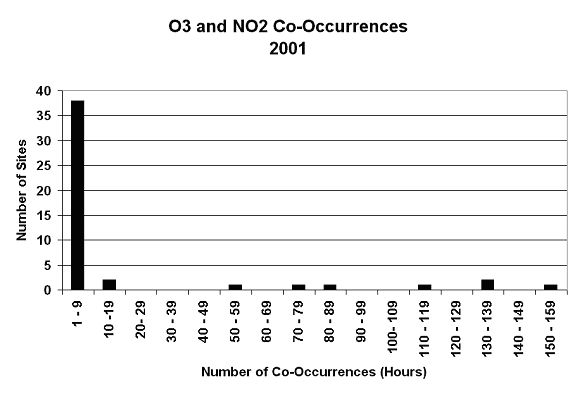Co-occurrence of Ozone with Nitrogen Oxides
Ozone occurs frequently at concentrations
equal to or greater than 0.05 ppm at many rural and remote monitoring
sites in the United States (U.S. EPA, 2006) as well as at policy-relevant
background monitoring locations. Therefore, for many rural locations
in the United States, the co-occurrence patterns observed by
Lefohn and Tingey (1984) for O3 and NO2 were defined by the presence
or absence of NO2. Lefohn and Tingey (1984) reported that most
of the sites analyzed experienced fewer than 10 co-occurrences
(when both pollutants were present at an hourly average concentration
greater than or equal to 0.05 ppm). Figure 1 summarizes the simultaneous
co-occurrence patterns reported by Lefohn and Tingey (1984).
The authors noted that several urban monitoring sites in the
South Coast Air Basin experienced more than 450 co-occurrences.
For more moderate areas of the country, Lefohn et al. (1987)
reported that even with a threshold of 0.03 ppm O3, the number
of co-occurrences with NO2 was small.
Using 2001 data from the EPA AQS database,
patterns that showed air pollutant pairs of O3/NO2 appearing
at the same hour of the day at concentrations equal to or greater
0.05 ppm were characterized. The data were not segregated by
location settings categories (i.e., rural, suburban, and urban
and center city) or land use types (i.e., agricultural, commercial,
desert, forest, industrial, mobile, or residential). Data capture
was not a consideration in the analysis. The data were characterized
over the EPA-defined O3 season. In 2001, there were 341 monitoring
sites that co-monitored O3 and NO2. Because of possible missing
hourly average concentration data during periods when co-monitoring
may have occurred, no attempt was made to characterize the number
of co-occurrences in the 0 category. Thus, co-occurrence patterns
were identified for those monitoring sites that experienced one
or more co-occurrences.

Figure 1. The co-occurrence pattern for
ozone and nitrogen dioxide (Source: Lefohn and Tingey, 1984).
Figure 2 illustrates the results of the
analysis. Similar to the analysis summarized by Lefohn and Tingey
(1984), most of the co-located monitoring sites analyzed, using
the 2001 data , experienced fewer than 10 co-occurrences (when
both pollutants were present at an hourly average concentration
greater than or equal to 0.05 ppm).

Figure 2. The co-occurrence pattern for
ozone and nitrogen dioxide using 2001 data from AQS.
References
Lefohn, A. S.; Tingey, D. T. (1984) The
co-occurrence of potentially phytotoxic concentrations of various
gaseous air pollutants. Atmos. Environ. 18: 2521-2526.
Lefohn, A. S.; Davis, C. E.; Jones, C.
K.; Tingey, D. T.; Hogsett, W. E. (1987) Co-occurrence patterns
of gaseous air pollutant pairs at different minimum concentrations
in the United States. Atmos. Environ. 21: 2435-2444.
U.S. Environmental
Protection Agency (2006) Air Quality Criteria for Ozone and Related
Photochemical Oxidants. Research Triangle Park, NC: Office of
Research and Development; report no. EPA/600/R-05/004af.